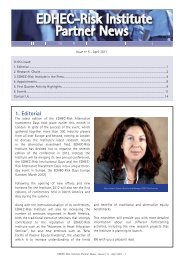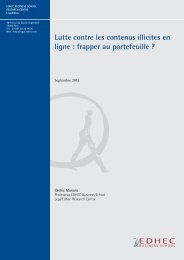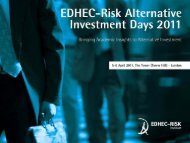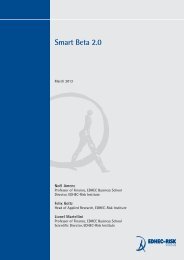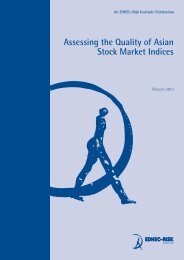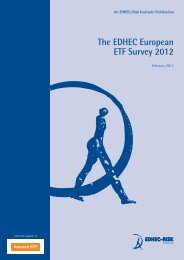The Smart Beta 2.0 Approach - EDHEC-Risk
The Smart Beta 2.0 Approach - EDHEC-Risk
The Smart Beta 2.0 Approach - EDHEC-Risk
Create successful ePaper yourself
Turn your PDF publications into a flip-book with our unique Google optimized e-Paper software.
An ERI Scientific <strong>Beta</strong> Publication — <strong>Smart</strong> <strong>Beta</strong> <strong>2.0</strong> — April 2013<br />
Copyright © 2013 ERI Scientific <strong>Beta</strong>. All rights reserved. Please refer to the disclaimer at the end of this document.<br />
15<br />
1. <strong>The</strong> <strong>Risk</strong>s of <strong>Smart</strong> <strong>Beta</strong> Strategies<br />
Hence we conclude that, in general, parameter estimation risk can be further decomposed as<br />
follows:<br />
Parameter estimation risk = parameter sample risk + parameter model risk (2)<br />
Here again, we feel it is important to stress that parameter estimation risk, with the notable<br />
exception of Equal-Weighting, does exist in the construction of <strong>Smart</strong> <strong>Beta</strong> benchmarks. On<br />
the other hand, the rhetoric from the promoters of fundamental or qualitative approaches,<br />
according to whom parameter estimation risk would arise only when some kind of<br />
optimisation is performed, does not seem to us to correspond to the reality of the risks.<br />
Indeed, any portfolio construction technique that uses parameters is confronted with the risk of<br />
estimating the parameters. <strong>The</strong> fact that these parameters are averaged accounting values as in<br />
the case of fundamental equity indexation strategies, which gives them less variability, does not in<br />
any way solve the problem of the out-of-sample robustness of the estimation of the parameters.<br />
On the contrary, the highly backward-looking aspect of parameter estimations based both on<br />
accounting values, and especially their average, often leads to parameter values that are highly<br />
sample-dependent. If we refer to the economic size of the banking sector, using an average of<br />
bank sizes between 2004 and 2008 as a proxy for the economic size in 2009 does not necessarily<br />
give particularly relevant values. Ultimately, by denying the estimation risks of non-quantitative<br />
schemes, the promoters of ad-hoc approaches that are referred to as qualitative do not position<br />
themselves well to manage these risks properly or to allow investors to analyse them. Indeed, the<br />
performance of fundamentals-based strategies are very sensitive to strategy specification as can be<br />
seen from Exhibit 5, which shows the maximum calendar year difference between different forms<br />
of fundamental indices, where fundamental weighted portfolios are constructed using different<br />
variants for each of the three specification choices – the choice of a fundamental weighting<br />
variable, that of a stock selection methodology and that of the rebalancing timing (while using the<br />
default choices for the other two specification choices 11 ).<br />
Exhibit 5: Maximum calendar year performance difference under different strategy specifications – <strong>The</strong> table shows the returns of best and worst<br />
performing variants for each specification of the fundamental weighting scheme on the universe of top 1000 US stocks. Variants for weighting<br />
variable selection are Book Value, Cash Flow, Dividends, Earnings, Net Sales, and an equally-weighted composite of these 5 fundamentals. Variants<br />
for stock selection are the top 1,000 stocks by fundamentals size and the top 1,000 stocks by market-cap. Variants for rebalancing are June,<br />
September, December, and March annual rebalancing dates. Portfolios are formed using fundamental data and monthly returns from the period<br />
January 1982 to December 2010 and are rebalanced annually. Returns and fundamental data are obtained from Datastream and Worldscope. All<br />
returns reported are geometric averaged and are annualised.<br />
Specification<br />
Best Performing Fundamental<br />
Equity Strategy<br />
Worst Performing Fundamental<br />
Equity Strategy<br />
Maximum return<br />
difference<br />
Variant Annual return Variant Annual return<br />
Variable selection Earnings -12.2% Dividends -23.0% 10.8% 1999<br />
Selection effect Fundamental<br />
4.6% Market Cap 2.3% 2.3% 2003<br />
selection<br />
selection<br />
Rebalancing Annual in March 11.3% Annual in<br />
September<br />
0.2% 11.1% 2009<br />
Year<br />
11 - <strong>The</strong> default choices of the specifications are composite weighting using the five variables, using the same fundamentals for stock selection, and<br />
rebalancing in June.




